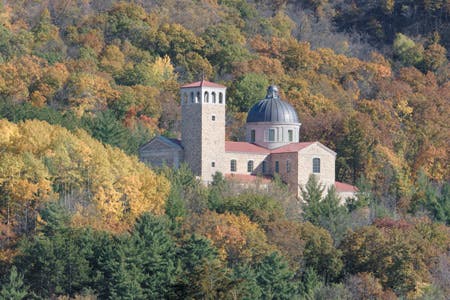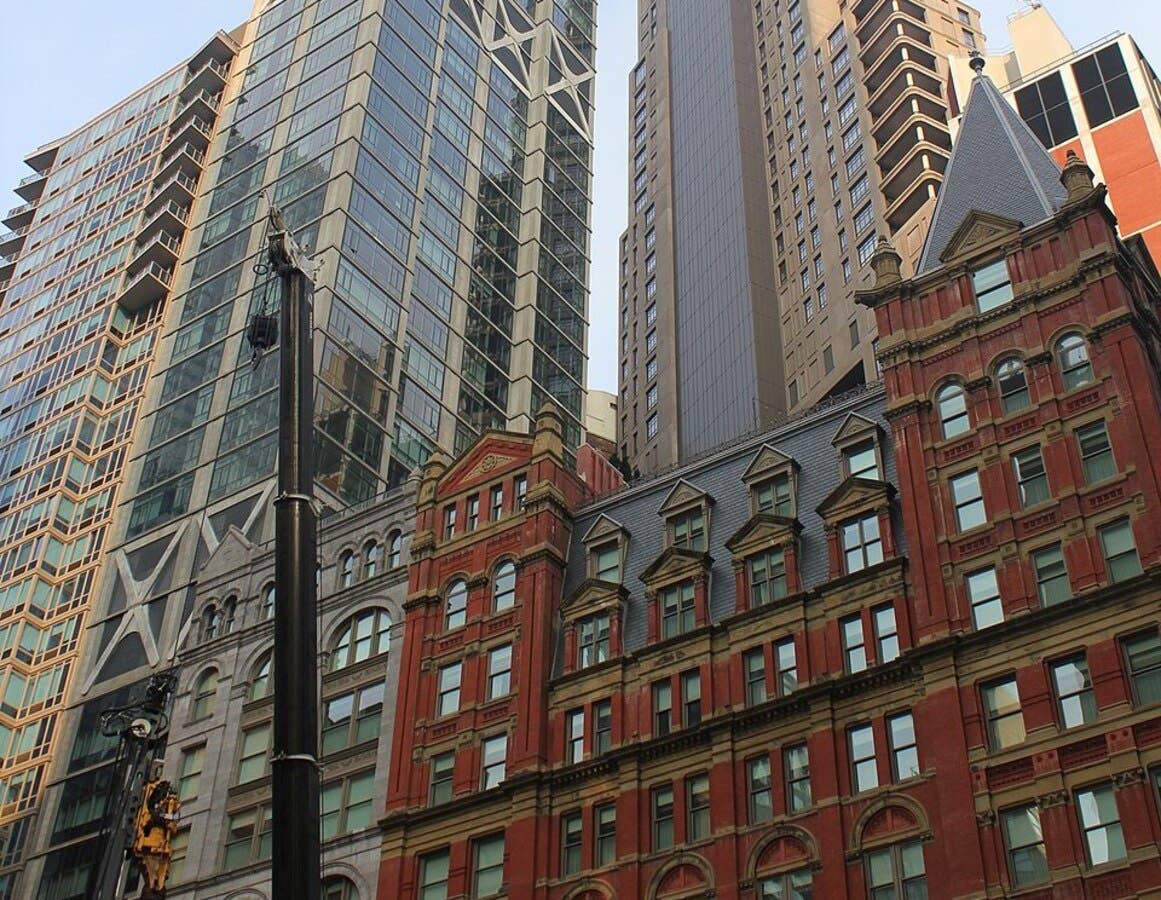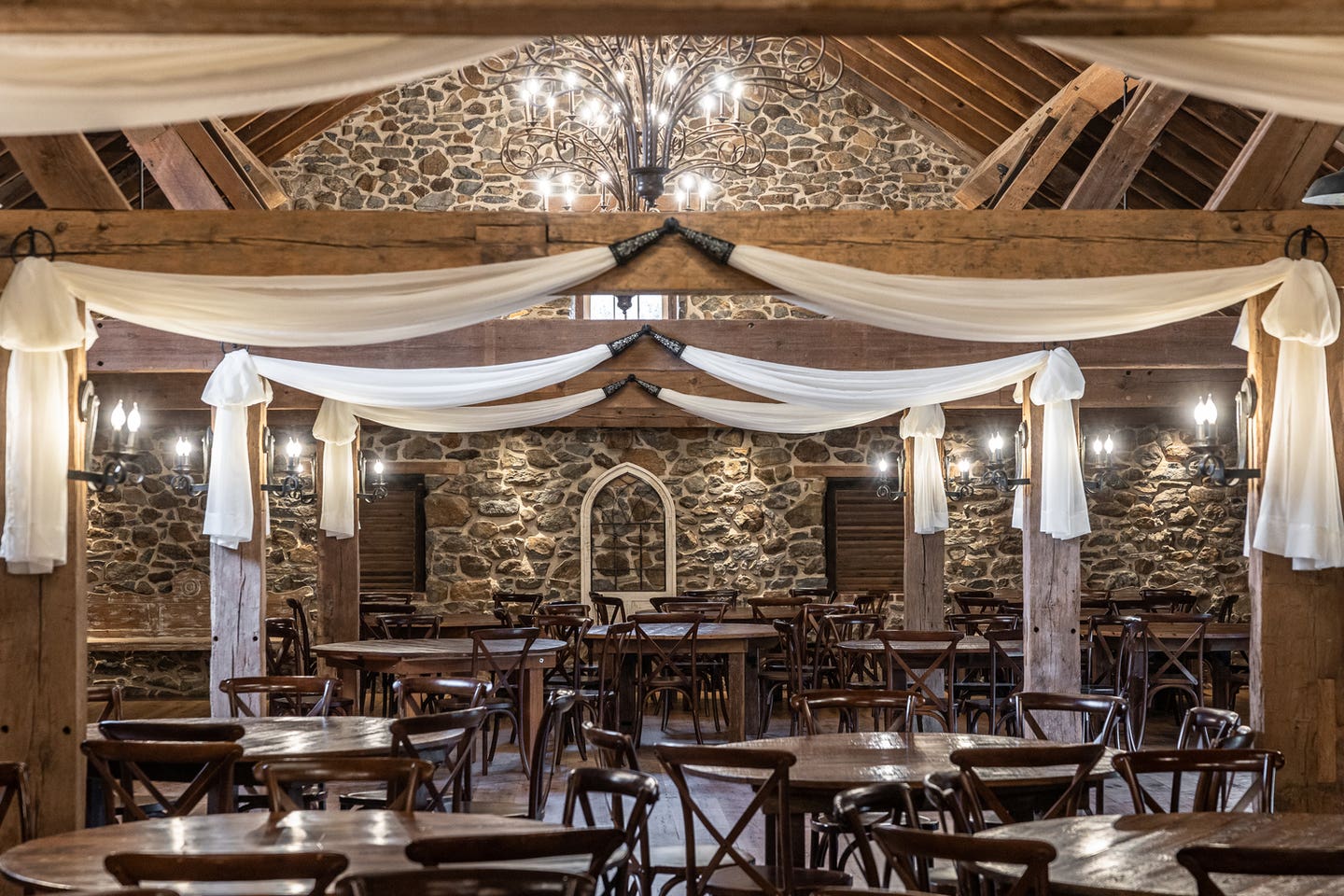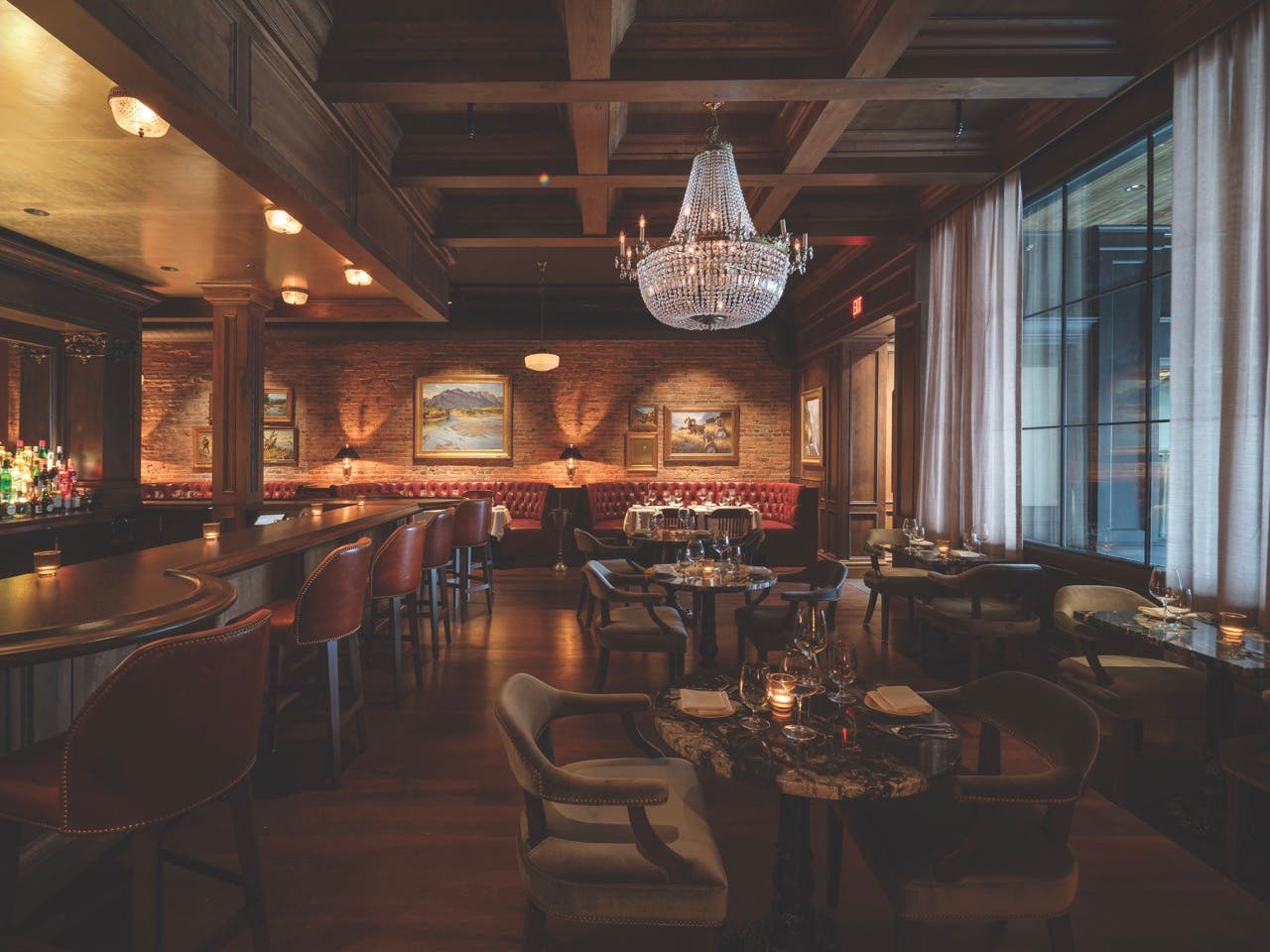
Religious Buildings
Classical Shrine | Our Lady of Guadalupe
Project
Our Lady of Guadalupe, La Crosse, WI
Architect
River Architects, La Crosse, WI
Design Architect
Duncan G. Stroik Architect, LLC, South Bend, IN
Construction Manager
Fowler & Hammer, Inc., La Crosse, WI
Nestled in the bluffs of Wisconsin on a 70-acre site is a new jewel of architecture, craftsmanship and faith. Conceived by and executed under the direction of His Excellency Raymond L. Burke, Prefect of the Apostolic Signatura (formerly Bishop of La Crosse, WI), the Shrine of Our Lady of Guadalupe is a rare example of new church construction in the classical style. In fact, it is said to be one of the few churches built in the classical style in the U.S. in the past 50 years.
The shrine includes not only the 21,000-sq.ft. church, but also a number of other buildings. It is the church itself, however, with its campanile and extraordinary interior ornamentation that makes it so exceptional. "There have been some buildings like this built in the past 50 years," design architect Duncan G. Stroik of Duncan G. Stroik Architect, LLC, of South Bend, IN, notes, "but this is extraordinary both because of the emphasis on quality and the integration of the arts, including painting and sculpture. It was a once-in-a-lifetime project for everyone involved."
Completed earlier this year, the church was a seven-year project, says Stroik, explaining that it included three years in the design phase and four years of construction. While the exterior is simple, "like a Tuscan church, stone and tough," the interior is more like a high renaissance or baroque church, he adds. "The interior architecture is the equivalent of Bach in music, it is a fairly complex composition, with themes that develop as one visits the temple. This is the grandest building we have ever done in terms of design work, ornamentation, artistry and complexity."
One of the greatest challenges, according to Stroik, was designing a relatively small church with a "sense of grandeur and generosity. We were restricted by the size of the location where the county would allow us to build so we didn't have the flexibility on size and location on the side of the hill. It was also difficult getting the materials to the site."
Other challenges involved the classical design. "There are all types of problems that come up when you are designing a complex classical building," Stroik explains, "in creating the dome, the large pilasters, how to create a rhythm that would have an interruption at the dome and go back to the sanctuary. And the interior/exterior needed a certain relationship. We had no desire to make the exterior as complex as the interior." The simpler exterior is made of stone from Minnesota and Wisconsin that was blended to get a colorful mixture. Gray limestone was used for the cut details.
"As much as the exterior of Our Lady displays the special nature of this shrine, it is its breathtaking interior that embodies its spirit," says David Riccio, principal and project manager with John Canning Studios of Cheshire, CT, the firm that was contracted for the ornamental plastering and design and execution of the decorative painting in the interior. "In a day and age of minimalist interpretations where 'less is more,' this ambitious project dared to awe the visitor with prolific ornamentation and decoration. It was to be achieved through a high level of attention to classical detailing, using traditional materials and techniques."
"Everything has meaning, and there is a rationale for all the design elements, details and colors" says founder and president John Canning. "We wanted to create a glow, somewhat of a mystique. The space is filled with a glorious blending of cast ornamental plaster, decorative treatments, ecclesiastical iconography and artwork." He adds that much of the interior was inspired by the interior of Santa Maria Maggiore in Rome.
"Perhaps the most ambitious undertaking of all in the design and creation of this shrine was in its ornamental plaster," Riccio notes. "Almost every architectural element throughout the massive interior has been carefully detailed and crafted from cast plaster, including the six-ft. tall classical entablature which encircles the nave, transepts and sanctuary. It presented the greatest challenge as it transitioned around pilasters, the central crossing below the dome, and into the radius of the apse. A custom framework needed to be erected around the full perimeter of the space to hold the great weight of the plaster."
Canning's plasterers produced some of the moldings on site; however, Canning employed Felber Ornamental Plastering Corp., Norristown, PA, as the supplier for the majority of the plaster moldings. "Shop drawings of the plaster castings were reviewed down to sixteenths of inches in order to correctly represent classical design proportions," explains Riccio. "Once the castings were secured in place, each joint, each miter, required precision tooling similar to that of fine carpentry, but on a much grander scale. You might think it all comes together like a giant erector set, but the huge scale of these pieces inherently results in minor twists and warps. It truly requires an experienced hand to ultimately align the work and make it magically appear monolithic."
In addition to the great entablature, cast plaster embellishes the central dome, columns, piers, pilasters, window openings and entranceways. "The finely detailed ornamental plaster continues beyond these strictly architectural elements and into the realm of symbolism as well," says Riccio.
Dominating the transepts are classical major shrines to the Sacred Heart and the Immaculate Heart. Cast plaster columns and a colossal pediment, frame natural polished stone (rosso orobico) at each of these shrines. Lining the side aisles, classical minor shrines have been created from cast plaster in a similar fashion to the grander transept shrines, to frame newly commissioned commemorative artwork.
Among the greatest of tributes to Santa Maria Maggiore is the marble baldacchino. It features a coffered dome, delicately curved cornice and intricate angel valence created by skilled craftsmen. At comparatively smaller scales, custom sculpted and cast plaster artwork punctuates the architrave and frieze with floral garlands along with some 30 unique iconographic symbols, once again melding the artistic, architectural and religious nature of the space.
For the decorative painting, Canning understood that the decoration needed to draw its inspiration from two separate sources: the architecture and the sacred symbolism. On the first count, Canning quotes notable 19th century British architect, decorative artist and author of The Grammar of Ornament, Owen Jones, when he said, "Form without color is like a body without a soul." His Proposition 1 states, "The Decorative Arts arise from and should properly be attendant upon, Architecture."
On the second count, Canning grasped the significance of Our Lady of Guadalupe. "Before Our Lady appeared to Juan Diego in December 1531, only the Aztec emperor could wear the turquoise color," Canning relates. "Every element of Her image, every nuance and motif, was an important teaching tool in the 16th century New World. Those are the elements we drew on for this interior."
Canning blended a raw umber based color for the walls to act as a backdrop for the colorful shrines in the side aisles and transepts, for the magnificent baldacchino in the sanctuary, and the mosaic image of Our Lady at the altar. "The palette was not chosen from manufacturer's paint chips, but rather mixed and developed just for this space," says Canning, "first in our studios, and then tweaked and perfected on site. The creamy yellow used on the vaulted ceiling is inspired by the tones of the quarries in the stained glass windows, and the turquoise color strategically placed throughout is taken from Our Lady's mantle. These neutral backgrounds and highlights were painstakingly selected to create the warm glow and mystique that I sought."
The rich detailing of the cast plaster architectural elements was further enhanced with traditional decorative techniques. Approximately 28 different marbleized finishes and three granite finishes were executed by artists from Canning Studios. Gold, aluminum and Dutch metal gilding further embellish the traditional detailing. In the side aisles, the columns of the minor shrines are leafed using a "tone-on-tone" technique. Much of the gilding is glazed, stenciled or textured to simulate other finishes, such as bronze.
In the transepts, the masculine tones of red and gold dress the Sacred Heart shrine, while cream shades and soft silver create a style that is appropriately feminine to the Immaculate Heart imagery. Flanking the sculpted and brightly painted Marion symbols along the architrave, are silver leafed swagged garlands of Castilian roses, continuing the feminine theme. Above, on the marbleized entablature, a simulated gold mosaic frieze bearing turquoise-colored ecclesiastical inscriptions bands the interior and the base of the dome.
The ornate baldacchino employs more of the traditional decorative vocabulary used in its surroundings: a marbleized inner dome and cornice, and a gilded and glazed metallic valance. Directly above it on the ribbed sanctuary ceiling is the detailed plaster medallion with gilded and glazed rosettes. Canning refers to the completed decoration as "a tour de force of marble and metals."
Stroik notes that a great deal of attention was paid to the selection of the marbles used throughout the church. "My goal was to build an American interpretation of a high Renaissance Italian church," he states, "so we were very interested in the marble. We were looking for something classic, so it would look timeless. Then Canning took our initial designs and developed the decorative painting scheme. The faux marbling, for example, had to work together with the actual marble. We looked at examples in Europe and in America. John would do parts of the building and decide it wasn't right, so he would redo it. They did a splendid job."
Most of the marble was supplied by Twin City Tile and Marble Co. of St. Paul, MN, and their Italian counterpart, Italmarble Pocai SRL of Pietrasanta, Lucca, Italy.
The project also included 31 new stained-glass windows that were designed, fabricated and installed by Rohlf's Stained & Leaded Glass Studio of Mt. Vernon, NY. "This was a very extensive, once-in-a-lifetime project for us," says Peter Rohlf, CEO. "We won the project through an international competition. We have done a lot of churches, but nothing like this. They wanted Romanesque-style traditional windows. It was a dream come true to do this job." Rohlf's supplied various sizes of windows for the church, featuring different designs, some figurative and some symbolic. The Rohlf's stained-glass artist for the project was Alex Siderov.
Woodwork throughout the church including the pews, doors and scaristies is all mahogany. It was fabricated by Heebink Architectural Woodwork, Baldwin, WI.
One of the most striking parts of the church is the 35-ft. dia. dome that rises approximately 98 ft. above the marble floor at the crossing. It has been decorated with a unique design inspired by the sacred symbolism of Our Lady of Guadalupe. Our Lady's mantle is covered with stars mapping out various constellations consistent with what astronomers believe was in the sky above Mexico City the day her image was formed on December 12, 1531. With the assistance of astronomers at the Talcott Mountain Science Center in Avon, CT, a sky map of the constellations for that date and geographic location was obtained. Using this information, Canning Studios craftspeople developed the design and layout of stars for the dome.
The stars are eight-pointed to represent Holy Baptism, and their sizes vary in correlation to the range of five stellar magnitudes visible by the unaided human eye. Each star is hand stenciled and gilded with 23k gold leaf, and is set against a turquoise color night sky to match the color of Our Lady's mantle.
Surrounding the central image of Our Lady at the altar is a hand stenciled backdrop composed of the glyphs seen on her tunic; they are representative of flowers and leaves important to the Indians. Similarly, Canning Studios also designed stenciled diaper patterns for backgrounds at the shrines of Juan Diego and St. Joseph which flank the sanctuary.
Stroik notes that seven years is a long time for a contemporary project, but not that long when compared to the construction of other historic churches. "Most of today's clients don't have a four-year construction frame in mind," he says. "The church was raising money the whole time, so that allowed us to be diligent about the construction. You don't want to rush something like this. It will be around for a long time."








